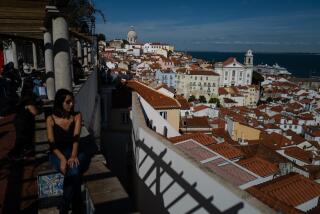An open door to the real Africa
- Share via
PRAIA, Cape Verde Islands — African adventures have caught the imagination of Western travelers for centuries, but the political instability, fear of violence and health hazards that blight many countries on that continent have stunted the growth of tourism.
Yet , for those wanting to savor raw Africa in relative safety and comfort, the tropical Cape Verde Islands are an enticing destination.
This Atlantic archipelago of 10 volcanic islands and eight islets 360 miles off the West African coast is largely undeveloped, and its centuries-old traditions -- which grew out of the slave trade -- have been preserved.
“It’s such authentic Africa,” says Ann-Marie Kraatari, a Finn who works for the United Nations in Rome.
Kraatari and her companion, Nicolas Bidault, a Rome-based French engineer, recently were on an island-hopping tour of Cape Verde.
“We wanted to see the real Africa, but in a place where there was no real danger,” Bidault said at the small but tidy airport here. “It’s a destination that’s not yet been colonized by tourists.”
Both are in their late 20s and stress that they are happy to endure some of the less hygienic conditions of independent travel and last-minute accommodation.
“We don’t mind rough traveling, but you have to be prepared,” Kraatari says.
The first Portuguese settlers landed on Santiago island in 1462 and established what is said to be the oldest European city in the tropics -- Ribeira Grande, now called Cidade Velha (“Old City”). They brought slaves from West Africa to carry out the hard labor of making these uninhabited islands habitable and to work on cotton plantations.
Within a few years Cape Verde, then one of Portugal’s five African colonies, began to prosper as a convenient staging post for the flourishing trans-Atlantic slave trade. For more than three centuries West African natives were captured and brought to these islands for sale to European slavers who took them to the New World.
Cidade Velha’s wealth attracted unwanted attention: In 1585 the port city was plundered by England’s Sir Francis Drake, and in 1712 the infamous French pirate Jacques Cassart devastated the city, triggering a decline from which it never recovered.
Now it is a ramshackle town, 6 miles west of the capital Praia, at the mouth of a lush valley where a few thousand people live off fishing and subsistence farming. Naked children spill from doorless one-room houses and sprint to the beach. Scrawny dogs nap in the shade, twitching their ears to shake off flies; goats nibble at leaves; and black pigs meander down the cobbled streets.
The old buildings are in ruins. The roofless Sao Francisco convent is partly concealed beneath fast-growing tropical vegetation. Only the thick walls of the seafront Roman Catholic cathedral, destroyed by cannon fire from pirate ships, still stand. At the Nossa Senhora de Rosario church, built by slaves, two faded gravestones carry the years 1604 and 1611.
Overlooking the town is the 16th-century Sao Filipe clifftop fort, where hefty cannon lift their iron snouts to the horizon. It is being excavated and restored -- part of a government plan to use the country’s historical sites for cultural tourism.
“We call Cidade Velha the cradle of our nation -- this is where we began,” says Dilma Cunha of the Ministry for Culture, who is overseeing the restoration project. “We’ve got a lot to tell.”
She says hundreds of shipwrecks, many sunk by the fort’s cannon, have been located in the craggy bay’s turquoise waters and will be a draw for scuba divers.
Apart from the pelourinho, a carved marble pillar where slaves were publicly flogged, there are no monuments in the town square -- neither here nor anywhere in the islands -- to recall the tens of thousands of slaves who passed through the archipelago.
But, in fact, evidence of the slaving history is all around -- in the mostly mulatto people of European and African descent; their creole language, which blends Portuguese with West African dialects; the European influence in their cuisine; and their folk music, called morna (from the English “to mourn”) which takes its cue from European, Latin American and African rhythms.
Cape Verdeans began emigrating in significant numbers to New England in the United States in the first half of the 19th century. Whaling ships working in the seas off Cape Verde recruited local fishermen who then settled on the other side of the Atlantic.
The abolition of slavery in 1876 heralded Cape Verde’s economic decline. However, the port city of Mindelo, on the island of Sao Vicente, led a revival as a refueling stopover for trans-Atlantic ships.
English companies established coal stations in the early 19th century, and in 1889 almost 2,000 merchant vessels -- an average of more than five a day -- anchored in Mindelo’s bay, giving rise to a cosmopolitan city enlivened by sailors of numerous nationalities.
Mindelo, which sits beneath flinty peaks, has a strong Portuguese colonial feel. A few vehicles trundle along the cobblestone avenues past picture-post card houses painted in pastel blues, greens and pinks with white balustrades.
The bars and cafes in Mindelo, which has a population of 47,000, are crammed full of revelers on weekends, and talented local amateurs sing on stage at places such as Cafe Marseilles.
Shipping in Cape Verde after World War I diminished as it was overshadowed by Spain’s more developed Canary Islands to the northeast.
As well as economic decline, lengthy droughts -- worsened by overgrazing and deforestation -- bled life from the islands and prompted a wave of emigration. The official population of the islands is about 405,000, but the government estimates that double that number work abroad, especially in the United States and Europe.
During the 1961-75 struggle for independence from Portugal, the Portuguese found uses for Cape Verde: It was used as a garrison by the Portuguese army, though there was almost no fighting here, and Lisbon set up its infamous prison at Tarrafal on Santiago Island.
The now-abandoned prison is being converted into a museum. It once held more than 300 convicts and political opponents of Portugal’s 41-year dictatorship, set up by Antonio Salazar in 1933.
There is a beautiful mountain view from its grassy courtyard, over the thick walls built of sharp-edged volcanic rock. The isolation cells and the torture chamber, used by the Lisbon dictatorship’s feared secret police, are still there, though the gruesome instruments in the chamber have been temporarily removed.
Now sparrows and swallows swoop in and out of the silent, single-story cell blocks, and flowers grow in the moat behind rusty barbed wire that once was electrified. Tarrafal also has a spectacular beach and pale green sea within its broad horseshoe bay. At the beachfront Baia Verde Hotel, tourists, most of them German, relax on hammocks slung between palm trees after a morning of hiking or scuba diving.
“These people are looking for something earthy, less sophisticated than what they might get elsewhere,” says Manuel Goncalves, the hotel’s Cape Verdean owner.
The 27-mile car journey from Praia, the capital, in the south to Tarrafal on the northern side of Santiago, weaves through the island’s mountainous interior. It is a thrilling journey through fertile, misty valleys and along the spines of narrow ridges that are strongly reminiscent of South American cordilleras.
Farmers trudge up the steep, terraced hillsides, and brightly colored birds twitter and flit between trees.
Praia, the nation’s administrative capital, is a quiet city of low buildings and dusty streets. It is cupped around a small central plateau where the noisy market offers piles of local produce -- green peppers, red tomatoes, purple sweet potatoes and woody-brown mandioc. And a million tireless flies.
After Cape Verde’s 1975 independence, a Marxist government ruled the country as a one-party state, crippling economic development. Since democracy was introduced in 1991, power and phone lines have snaked across the islands and the government is keen to nurture the tourism industry, largely through foreign investment. A second international airport is being built on Santiago island.
The four-star, all-inclusive resorts on the golden beaches of Sal Island, where the only international airport is, offer package holidays for European holiday makers, though they provide only the merest glimpse of the islands’ true character.
The guests here, mostly Portuguese, Italian and German, include honeymooners, families and retired people. The common denominator is that they all are content with a beach holiday.
More hotels are being built on other islands, upon which visitors can explore a broader range of possibilities: the lush mountains for hiking or cross-country cycling, arid moonscapes, pristine beaches, water sports such as wind surfing and scuba diving -- and genuine African culture.
More to Read
Sign up for Essential California
The most important California stories and recommendations in your inbox every morning.
You may occasionally receive promotional content from the Los Angeles Times.











